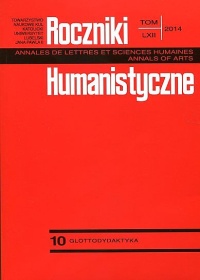How to Teach a Foreign Language? The Use Songs in Teaching Polish as a Foreign Language
Abstract
The effective language teaching, Polish language teaching included, depends on a number of factors. Each time a teacher prepares his or her classes, he or she must adjust the teaching resources to the objectives, students’ proficiency level, their needs and general competencies. It is a common knowledge that a standard coursebook is not sufficient a tool to teach a foreigner Polish language and arouse his or her interest in particular issues, or to show the usefulness of grammar forms or structures. It seems that the use of songs in a language class is something that may do the trick. The specialist literature regarding the subject describes various roles of music in the learning process, enumerates the conditions which should be met by a piece of music to be a worthy language teaching tool, introduces a number of exercises for foreign students, adjusting them for different goals and needs. Apart from a vast number of criteria for the selection of a song, its topicality should be one of the most pertinent prerequisites. Unfortunately, as may be observed in Polish as a foreign language teaching, it is an element of lesser importance, overlooked by coursebook authors and teachers. Students used to modern music have to listen to older songs, which are obsolete in the manner of lyrics and musical styles. Thus it is worthwhile to select each time the music currently popular among the young students, the kind of which they usually listen to, which will assure them that Polish will be useful for them in everyday life. Obviously, such songs have often little artistic or linguistic value, however, with proper elaboration of exercises, they could prove themselves a worthy didactic tool. At the lower course levels a teacher may introduce current and well-known songs instead of numbers with ambitious lyrics and complex melodies, even though it may not agree with the teacher’s taste or the concept of aesthetics.
References
Bourkane-Rotter A.: „Ładne słowo to...” – jak bawić się językiem, słuchając Marii Awarii, w: Kultura popularna w nauczaniu języka polskiego jako obcego. Materiały z konferencji naukowej, red. P. Garncarek, P. Kajak, Warszawa 2012, s. 139-146.
Janowska I.: Podejście zadaniowe do nauczania i uczenia się języków obcych na przykładzie języka polskiego jako obcego, Kraków 2001.
Kajak P.: Kultura popularna w procesie nauczania języka polskiego jako obcego, w: W poszukiwaniu nowych rozwiązań. Dydaktyka języka polskiego jako obcego u progu XXI wieku, red. W. Miodunka, A, Seretny, Kraków 2008, s. 291-292.
Lipińska E.: Księżyc w butonierce, Kraków 2004.
Madeja A., Morcinek B.: Polski mniej obcy. Podręcznik do nauki języka polskiego dla średnio zaawansowanych, Katowice 2007.
Majkiewicz A., Tambor J.: Śpiewająco po polsku, Katowice 2006.
Piskozub-Siek T., Wach A.: Muzyka i słowa. Rola piosenki w procesie przyswajania języka obcego, Poznań 2006.
Seretny A., Lipińska E.: ABC metodyki nauczani języka polskiego jako obcego, Kraków 2005.
Tworek-Majewska A.: Szura, szumi i szeleści, Wrocław 2010.
Copyright (c) 2014 Roczniki Humanistyczne

This work is licensed under a Creative Commons Attribution-NonCommercial-NoDerivatives 4.0 International License.





